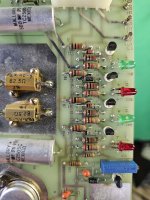Well, this was supposed to be an exercise for our friend to work out, not a lecture.
The math is even simpler if you go: V/R=I, so that'll give you the current through the part. Multiply that I by the V to get power in Watts.
Except that that's the absolute maximum power dissipation if you clamp that resistor between the supply rails, but that's not what's happening here - these bus signals have a much lower duty cycle, so a 1/4W resistor isn't going to break a sweat, let alone burn a finger.
Yes as you point out, if the waveforms are pulses the power drops.
One interesting thing, if you have a pulsed DC waveform, with say a 50% duty cycle, like a square wave, you end up dissipating half the power.
This fact can be used to avoid doing the calculus when somebody asks the question :
What is the equivalent rms voltage, if you pass a sinewave, like the 115V AC line power via a rectifier, to say power a lamp with half wave AC ?
Since the power is halved, but power relates to the square of the voltage, and say if you consider the original power P1 and Voltage V1 and the power after half wave rectification P2 and the new rms voltage V2, and the fact that P2 = P1/2 then V1^2 = 2V2^2 , then V2 = V1 x 1/root2 = V1 x 0.707.
So if you half wave 115V line power through a rectifier, the equivalent rms voltage (heating voltage) is 0.707 x 115 = 80.5 volts (a poor man's light dimmer perhaps, the diode power losses are small). But it avoids the math, having to integrate the half wave rectified waveform over the 360 degrees of the cycle.
I prefer to avoid excessive math myself, but I still like to know how to do it.
I found it was possible to solve the resistor cube question, using virtually no math at all, if I invoked the notion of a Bandsaw cutting up metal plates. This can be atonement for the lecture you accused me of:
www.worldphaco.com/uploads/A_SELF_EVIDENT_SOLUTION_TO_THE_RESISTOR_CUBE_QUESTION_USING_THE_BANDSAW_METHOD.pdf

